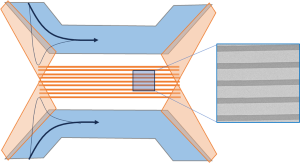Projects
Field-Driven Ion Transport and Reactivity
Principal Investigator: Elias Nakouzi
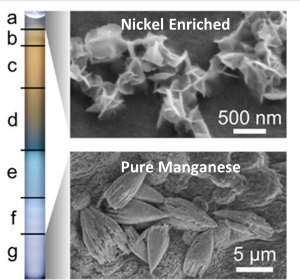
Selective precipitation, a commonly used method in chemical separations, often faces limitations in applicability and efficiency due to the comparable solubilities of the ions of interest. This issue usually results in a mixture of desired and undesired products, necessitating additional energy- and chemical-intensive processing steps for complete separations. We propose an innovative approach that leverages the non-equilibrium coupling of ion transport and precipitation kinetics, offering a fresh perspective on chemical separations. By balancing the diffusion and nucleation kinetics of competing ions, our method will precipitate these species selectively and sequentially. Our objective is to facilitate the efficient separation of rare earth elements, transition metals, and other critical materials from unconventional domestic feedstocks. Our method avoids using membranes, ligands, toxic solvents, or other specialty chemicals, thereby enhancing its environmental sustainability and adaptability to different feedstocks. To achieve this goal, we will develop a fundamental understanding of how external fields influence (1) ion speciation and transport and (2) ion precipitation kinetics from multicomponent solutions. By investigating these essential aspects, we will revolutionize the field of chemical separations, making it more efficient, adaptable, and sustainable.
On-Line Monitoring of Complex Real-World Feedstocks
Principal Investigator: Amanda Lines
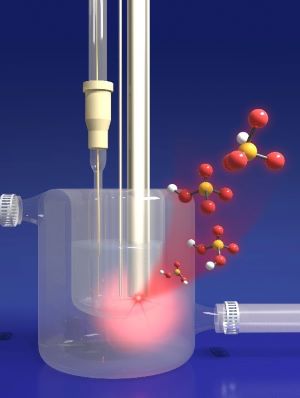
A practical challenge in separating critical materials from complex, real-world feedstocks is the quantitative monitoring and measurement of the targeted species throughout the separation process in a complicated and evolving matrix. We will devise and validate on-chip sensors that deliver in situ, real-time chemical composition analysis. This capability will elucidate the chemical and physical process efficiency of flow- and field-driven separations within model microfluidic devices. Such insights will illuminate the fundamental chemistry of separation processes and provide valuable data to inform the scale-up and deployment of far-from-equilibrium conditions to applied separations. We will employ optical spectroscopy techniques and chemical data science methods, such as chemometric analysis, to dissect intricate data streams. This approach will facilitate highly precise, real-time analyses and adaptive process control. Our strategy will enable novel advances in flow- and field-driven separations, potentially unveiling new chemical insights and enabling instantaneous process optimization.
Spatiotemporally Resolved Multiscale Modeling
Principal Investigator: Jaehun Chun
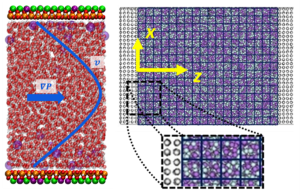
C. Nieto-Draghi, B. Rotenberg,
Mineral- and ion-specific effects
at clay−water interfaces: Structure,
diffusion, and hydrodynamics.
J. Phys. Chem. C 122, 18484-18492 (2018). |
B. J. Palmer, J. Chun, J. F. Morris, C. J.
We will develop a theoretical model to predict the transport of rare earth elements and other critical minerals in aqueous solutions driven by flow and external fields. We will utilize a combination of state-of-the-art molecular simulations and statistical mechanical schemes to comprehensively understand the interplay between molecular-scale chemical physics and bulk ion transport properties under external fields. The new predictive model will connect the chemistry-specific molecular responses associated with interfacial chemistry and ion-specific concentrations to macroscopic complex fundamental transport property-based descriptions. This project will build a key computational capability for understanding transport-based separations over spatiotemporal scales under far-from-equilibrium conditions inaccessible via traditional molecular-scale simulations.
Hydrothermal Field-Driven Separation of Rare Earth Elements
Principal Investigator: Xin Zhang
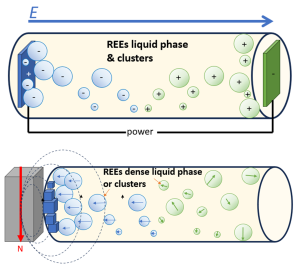
We will develop sustainable and efficient rare earth element separations based on electric and magnetic field-driven fractional crystallization at hydrothermal temperature and pressure conditions. We will investigate the evolution of rare earth element–anion complexes, clusters, and dense liquid phases to elucidate the tunability of fractional crystallization mechanisms and selectivity in nucleation and particle growth processes. We will obtain fundamental insights into rare earth element precipitation processes employing distinguishing in situ Raman, time-resolved, laser-induced fluorescence spectroscopy, and X-ray scattering techniques coupled with hydrothermal diamond-anvil cells or fused silica capillary capsules.
Validation of Non-Equilibrium Separations in Complex Feedstock
Principal Investigator: Chinmayee Subban

We will identify sustainable resources and develop separation processes for critical materials, primarily focusing on unconventional feedstocks, such as diverse brines, industrial effluents, and recycling streams. Existing mineral separation and extraction methods are often costly and chemical- and energy-intensive as they depend on specialty chemicals, membranes, and solvents. They are also typically not broadly applicable to a diverse range of feedstocks. We will validate the potential of selectively extracting critical minerals using external flow- and field-driven precipitation without specialty chemicals and verify the associated reduction in process costs and environmental impact. We have demonstrated such non-equilibrium field-driven separation of critical elements using small volumes of model solutions. We will understand the scalability of this approach and its relevance to industrial-scale mineral extraction. Because real-world feedstocks are chemically complex and variable, we will investigate process efficiency as a function of critical element concentration and feedstock composition using experiments, modeling, and online monitoring of both model synthetic and real-world feedstocks. Our results will inform scale-up, life cycle, and techno-economic analyses, thereby determining the commercial relevance of external field-driven separations.
Probing Field-Driven Ion Transport and Reactivity
Principal Investigator: Venky Prabhakaran
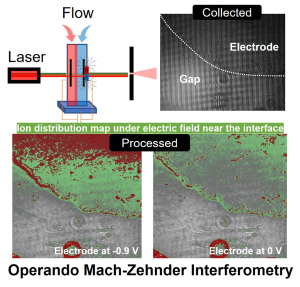
We will build minimally invasive operando experimental probes to directly visualize non-equilibrium processes emerging across relevant spatiotemporal scales in complex chemical mixtures with variable composition under liquid flow and applied electric and magnetic fields. These novel operando spectroscopy and microscopy tools will be used to establish causality between transport- and field-driven ion concentrations and measure (1) selective concentration gradients (i.e., ions, ion pairs, clusters, nucleates) across liquid–liquid interfaces and (2) the evolution kinetics of localized domains consisting of targeted ions (i.e., enrichment zones) near interfaces to enable selective precipitation reactions in complex aqueous solutions for non-equilibrium separations.
Modeling Specific Ion Responses to Electromagnetic Fields Across Fluid Domains
Principal Investigator: Maria Sushko
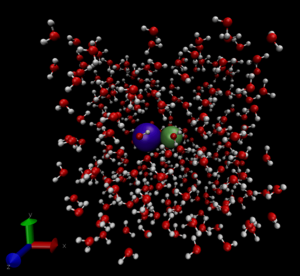
We will resolve the effect of coupled magnetic and electric fields on ion transport, speciation, and crystallization to facilitate separations from multicomponent mixtures. We will use a novel quantum chemistry approach within a many-body expansion formalism and ab initio molecular dynamics simulations to calculate the intrinsic properties of solvated ions, such as their charge density, excess polarizability, and magnetic susceptibility, to predict ion-specific responses to external fields. We will couple the data within a multiphysics approach that includes only elementary processes capable of affecting ion behavior and is sufficiently computationally efficient to encompass all solution species with realistic densities in cubic micron volumes. This approach will enable us to understand how the effects of hydrodynamic, magnetic, and electric fields drive ion transport and accumulation in targeted locations. We will test the hypothesis that local magnetic forces facilitate ion accumulation through positive feedback between field-induced concentration gradients and the formation of ion-specific magnetic domains and explore this effect as a driving force for ion-specific accumulation and precipitation from complex mixtures. The new theoretical framework will be an efficient capability for predicting electromagnetic field and flow conditions for efficient separations of critical materials from complex mixtures.
Theoretical Approaches for Far-from-Equilibrium and Non-Steady-State Conditions
Principal Investigator: Hadi Dinpajooh
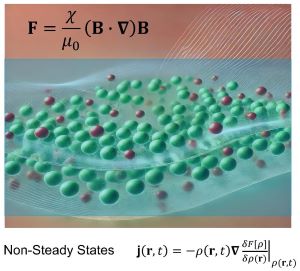
of generative artificial intelligence (AI)
by Hadi Dinpajooh | PNNL)
We will explore how inhomogeneous magnetic fields influence the motion of ions and solvent molecules, forming unique micro/nanodomains with distinct structural and dynamic properties. By leveraging these magnetic fields under far-from-equilibrium conditions, we will selectively separate correlated liquid domains and ions based on their magnetic properties. We will understand the dynamic evolution of these domains by developing accurate theoretical models and frameworks using new computational algorithms. The goal is to produce quantitative descriptions of micro/nanoscale interactions, critical for improving field-driven separation processes through magnetophoresis.
Understanding the Mechanisms of Selective Crystal Nucleation and Growth Using In Situ Electron Microscopy
Principal Investigator: Dongsheng Li
We will uncover the mechanisms of element-specific nucleation in mixed solutions, particularly at liquid–liquid interfaces and under external stimuli such as electric and magnetic fields. We will observe and control crystal nucleation and growth under far-from-equilibrium conditions using in situ transmission electron microscopy. We will induce selective nucleation and growth by employing a mixing flow channel and applying external fields, providing insights into the kinetics and dynamics of these processes. Our innovative methodologies will enable the extraction of critical materials from abundant domestic unconventional resources while developing a foundational molecular understanding of far-from-equilibrium separation processes that is applicable across systems.
Probing External Field Effects on Rare Earth Element Separations at Liquid/Liquid Interfaces
Principal Investigator: Mavis Boamah
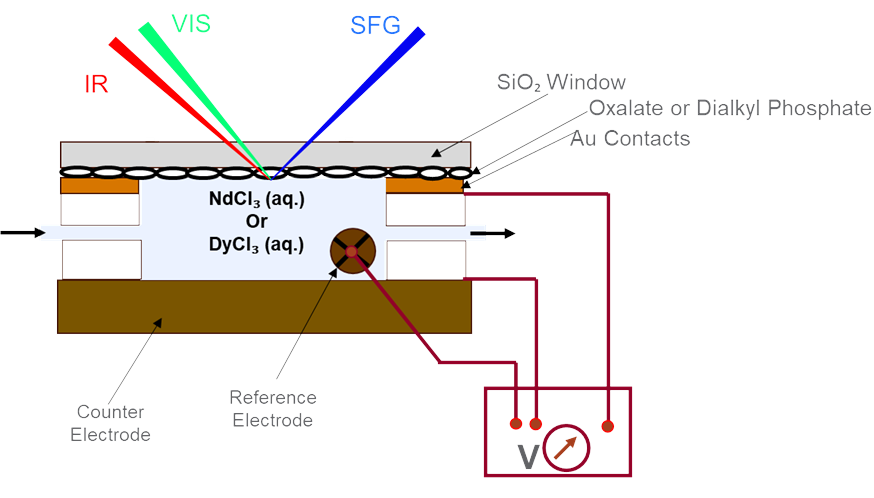
Emerging renewable energy technologies demand a sustainable and reliable supply of critical materials and rare earth elements (REEs). However, selective separation of REEs is challenging due to their similar physical and chemical properties. We will obtain a molecular-level understanding of non-equilibrium processes in liquid/liquid separations by developing an externally applied field vibrational sum frequency generation spectroscopy capability. By probing the effects of external fields at liquid interfaces, we will identify precursor species, changes in interfacial charge, and hydration states before precipitation. Manipulating interfacial potential based on pH, ionic strength, concentration, and applied external fields will allow us to control REE precipitation at aqueous interfaces. The molecular-level insights gained will enable us to better direct, predict, and control interface-driven liquid/liquid extraction of lanthanides and critical materials under flow conditions relevant for mineral processing and recycling.
Electrochemical Separation and Recovery of Critical Metals
Principal Investigator: Dan-Thien Nguyen; Co-principal Investigator: Ajay Karakoti
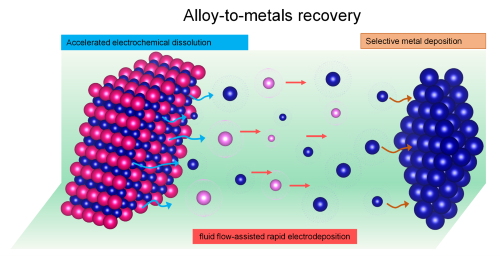
We will develop a flow-assisted direct alloy-to-metals (A2M) recovery process to enable energy-efficient recycling of end-of-life electronics and permanent magnets. The A2M approach seamlessly integrates electrochemical separation and electroplating into a single module operating at room temperature, facilitating the direct recovery of critical metals from metallic components of end-of-life products with high energy efficiency in an environmentally friendly manner. The system’s modular architecture will support continuous feedstock and chemical flow, facilitating integration into autonomous facilities. Our design will reduce operational costs, enhance atom and energy efficiency, and offer high customization based on feedstock composition.
Control and Measure Collective Ion Transport Under Inhomogeneous Electric and Magnetic Fields with Fluid Force Microscopy
Principal Investigator: Shuai Zhang
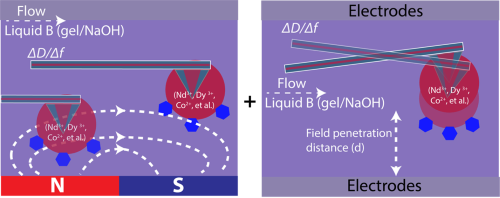
We will investigate non-equilibrium ion transport and nucleation driven by inhomogeneous electric and magnetic fields using a newly developed, noninvasive force mapping approach with nanometer-scale spatial and microsecond temporal resolution. This innovative method will bridge knowledge gaps in understanding how external fields influence interactions between critical material ions, enabling selective transport and precipitation. In operando, we will quantitatively measure the electrostatic and magnetic forces exerted on nanodroplets of critical minerals such as neodymium, dysprosium, and cobalt. These minerals are predicted to transport and selectively crystallize in laminar co-flow-based separations. Additionally, we will contribute to the development of predictive models that describe collective ion motion and nucleation, incorporating the effects of solvation environments and ion speciation under external stimuli.
